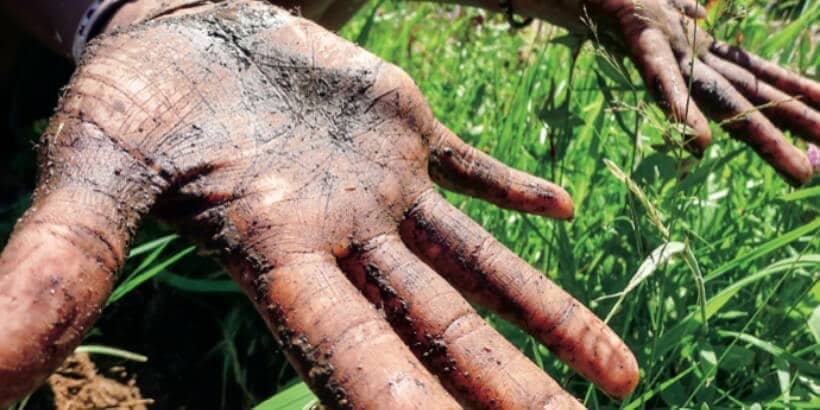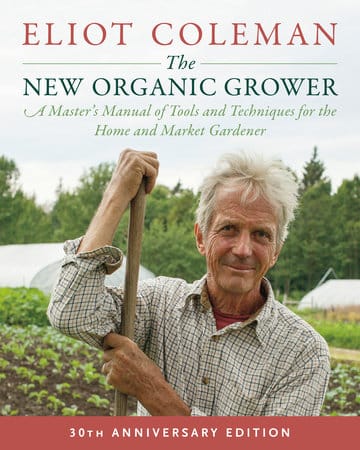Black Rural Land: Black Land Matters

As a young black girl, Leah Penniman struggled to understand who she was and where she fit in with the world. There was one thing she did know— when she was connected to the land and earth she felt at home.
But what did that mean? Was the land trying to tell her something about who she was and what the future had in store for her?
In celebration of Leah’s journey and the journey of many other Black farmers like her who have reclaimed their rightful place on the land, we’re sharing Leah’s story as published in her book Farming While Black. It has been adapted for the web.
Photo by Neshima Vitale-Penniman.
Revolution is based on land. Land is the basis of all independence. Land is the basis of freedom, justice, and equality. —Malcolm X
As a young person, and one of three mixed-race Black children raised in the rural North mostly by our white father, I found it very difficult to understand who I was.
Some of the children in our conservative, almost all-white public school taunted, bullied, and assaulted us, and I was confused and terrified by their malice. But while school was often terrifying, I found solace in the forest.
When human beings were too much to bear, the earth consistently held firm under my feet and the solid, sticky trunk of the majestic white pine offered me something stable to grasp.
I imagined that I was alone in identifying with Earth as Sacred Mother, having no idea that my African ancestors were transmitting their cosmology to me, whispering across time, “Hold on daughter—we won’t let you fall.”

Youth program participants at Soul Fire Farm place their bare feet on the soil. Photo by Leah Penniman
I never imagined that I would become a farmer.
In my teenage years, as my race consciousness evolved, I got the message loud and clear that Black activists were concerned with gun violence, housing discrimination, and education reform, while white folks were concerned with organic farming and environmental conservation.
I felt that I had to choose between “my people” and the Earth, that my dual loyalties were pulling me apart and negating my inherent right to belong.
Fortunately, my ancestors had other plans.
I passed by a flyer advertising a summer job at The Food Project, in Boston, Massachusetts, that promised applicants the opportunity to grow food and serve the urban community.
I was blessed to be accepted into the program, and from the first day, when the scent of freshly harvested cilantro nestled into my finger creases and dirty sweat stung my eyes, I was hooked on farming.
Something profound and magical happened to me as I learned to plant, tend, and harvest, and later to prepare and serve that produce in Boston’s toughest neighborhoods. I found an anchor in the elegant simplicity of working the earth and sharing her bounty.
What I was doing was good, right, and unconfused.
Shoulder-to-shoulder with my peers of all hues, feet planted firmly in the earth, stewarding life-giving crops for Black community—I was home.
As it turned out, The Food Project was relatively unique in terms of integrating a land ethic and a social justice mission. From there I went on to learn and work at several other rural farms across the Northeast.
While I cherished the agricultural expertise imparted by my mentors, I was also keenly aware that I was immersed in a white-dominated landscape.
At organic agriculture conferences, all of the speakers were white, all of the technical books sold were authored by white people, and conversations about equity were considered irrelevant.
I thought that organic farming was invented by white people and worried that my ancestors who fought and died to break away from the land would roll over in their graves to see me stooping. I struggled with the feeling that a life on land would be a betrayal of my people. I could not have been more wrong.
At the annual gathering of the Northeast Organic Farming Association, I decided to ask the handful of people of color at the event to gather for a conversation, known as a caucus.
In that conversation I learned that my struggles as a Black farmer in a white-dominated agricultural community were not unique, and we decided to create another conference to bring together Black and Brown farmers and urban gardeners.
In 2010 the National Black Farmers and Urban Gardeners Conference (BUGS), which continues to meet annually, was convened by Karen Washington. Over 500 aspiring and veteran Black farmers gathered for knowledge exchange and for affirmation of our belonging to the sustainable food movement.

Participants in Soul Fire Farm’s Black Latinx Farmers Immersion exchange a fist pump while tending to the onions. Photo by Leah Penniman
Through BUGS and my growing network of Black farmers, I began to see how miseducated I had been regarding sustainable agriculture.
I learned that “organic farming” was an African-indigenous system developed over millennia and first revived in the United States by a Black farmer, Dr. George Washington Carver, of Tuskegee University in the early 1900s.
Carver conducted extensive research and codified the use of crop rotation in combination with the planting of nitrogen-fixing legumes, and detailed how to regenerate soil biology.
His system was known as regenerative agriculture and helped move many southern farmers away from monoculture and toward diversified horticultural operations.1
Dr. Booker T. Whatley, another Tuskegee professor, was one of the inventors of community-supported agriculture (CSA),* which he called a Clientele Membership Club.
He advocated for diversified pick-your-own operations that produced an assortment of crops year-round. He developed a system that allowed consumer members to access produce at 40 percent of the supermarket pricing.2
Further, I learned that community land trusts were first started in 1969 by Black farmers, with the New Communities movement leading the way in Georgia.
Land trusts are nonprofit organizations that achieve conservation and affordable housing goals through cooperative ownership of land and restrictive covenants on land use and sale.
In addition to catalyzing the community land trusts, Black farmers also demonstrated how cooperatives could provide for the material needs of their members, such as housing, farm equipment, student scholarships and loans, as well as organize for structural change.
The 1886 Colored Farmers’ National Alliance and Cooperative Union and Fannie Lou Hamer’s 1972 Freedom Farm were salient examples of Black leadership in the cooperative farming movement.3
Learning about Carver, Hamer, Whatley, and New Communities, I realized that during all those years of seeing images of only white people as the stewards of the land, only white people as organic farmers, only white people in conversations about sustainability, the only consistent story I’d seen or been told about Black people and the land was about slavery and sharecropping, about coercion and brutality and misery and sorrow.
And yet here was an entire history, blooming into our present, in which Black people’s expertise and love of the land and one another was evident.
When we, as Black people are bombarded with messages that our only place of belonging on land is as slaves, performing dangerous and backbreaking menial labor, to learn of our true and noble history as farmers and ecological stewards is deeply healing.
Fortified by a more accurate picture of my people’s belonging on land, I knew I was ready to create a mission-driven farm centering on the needs of the Black community.
At the time, I was living with my Jewish husband, Jonah, and our two young children, Neshima and Emet, in the South End of Albany, New York, a neighborhood classified as a “food desert” by the federal government.
On a personal level this meant that despite our deep commitment to feeding our young children fresh food and despite our extensive farming skills, structural barriers to accessing good food stood in our way. The corner store specialized in Doritos and Coke.
We would have needed a car or taxi to get to the nearest grocery store, which served up artificially inflated prices and wrinkled vegetables. There were no available lots where we could garden.
Desperate, we signed up for a CSA share, and walked 2.2 miles to the pickup point with the newborn in the backpack and the toddler in the stroller. We paid more than we could afford for these vegetables and literally had to pile them on top of the resting toddler for the long walk back to our apartment.

Participants in Soul Fire Farm’s Black Latinx Farmers Immersion look super fly while hanging onions to cure in the barn. Photo By Leah Penniman.
When our South End neighbors learned that Jonah and I both had many years of experience working on farms, from Many Hands Organic Farm, in Barre, Massachusetts, to Live Power Farm, in Covelo, California, they began to ask whether we planned to start a farm to feed this community.
At first we hesitated. I was a full-time public school science teacher, Jonah had his natural building business, and we were parenting two young children.
But we were firmly rooted in our love for our people and for the land, and this passion for justice won out.
We cobbled together our modest savings, loans from friends and family, and 40 percent of my teaching salary every year in order to capitalize the project.
The land that chose us was relatively affordable, just over $2,000 an acre, but the necessary investments in electricity, septic, water, and dwelling spaces tripled that cost.
With the tireless support of hundreds of volunteers, and after four years of building infrastructure and soil, we opened Soul Fire Farm, a project committed to ending racism and injustice in the food system, providing life-giving food to people living in food deserts, and transferring skills and knowledge to the next generation of farmer-activists.
NOTES:
* Community-supported agriculture (CSA) is a food production and distribution system that directly connects farmers and consumers. In short: People buy “shares” of a farm’s harvest in advance and then receive a portion of the crops as they’re harvested.
- Jeffrey Jordan et al., Land and Power: Sustainable Agriculture and African Americans (College Park, MD: Sustainable Agriculture Research and Education, 2007), www.sare.org/content/download/50650 /665630/file/landandpower.pdf.
- Booker T. Whatley, Whatley’s Handbook on How to Make $100,000 Farming 25 Acres: With Special Plans for Prospering on 10 to 200 Acres (Kutztown, PA: Rodale Institute, 1987).
- Arc of Justice: The Rise, Fall, and Rebirth of a Beloved Community, Open Studio Productions, 2016, http:// openstudioproductions.com/store/arc-of-justice-the -rise-fall-and-rebirth-of-a-beloved-community.
Recommended Reads
Recent Articles
Aside from the sheer pleasure of telling your friends, straight-faced, that you maintain your garden using something called a “chicken tractor,” there are a slew of other benefits to working the land with a few of your animal friends. Getting rid of pests without chemicals, for one; letting them do the work of weeding and…
Read MoreIf the idea of running a vegetable farm sounds daunting, you’re not alone. What can you do to simplify techniques and reduce expenses? Where do you even begin?
Read MoreWhen you’re walking around the grocery store looking at the vegetables, it’s probably hard to imagine that a century ago there was twice the amount of options.
Read MoreIf you love tomatoes, you probably already know just how many varieties of these summertime staples there are. But do you know what makes each one unique?
Read MoreAdding the long game of trees to your system results in a deeper and more reliable, resilient and profound presence to your annual vegetable production.
Read More








